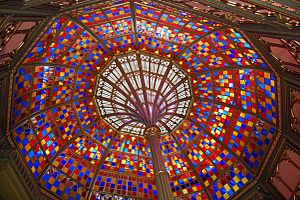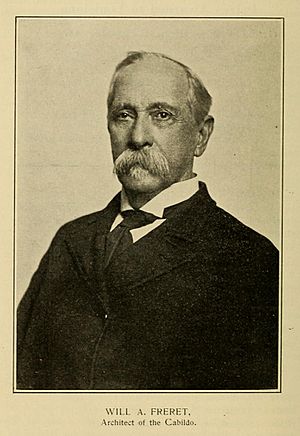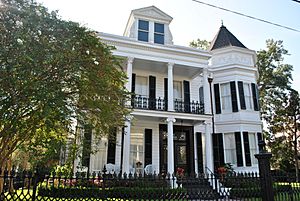William Alfred Freret facts for kids
William Alfred Freret, Jr. (born in New Orleans, Louisiana, on January 19, 1833; died in 1911) was an important American architect. He was in charge of the Office of the Supervising Architect from 1887 to 1888. This office was responsible for building many government buildings across the United States.
Many buildings he designed are special and are listed on the U.S. National Register of Historic Places. This list includes places that are important to American history.
About Will Freret
William Alfred Freret was born in New Orleans. His father, William Freret, was once the mayor of the city. His cousin, James Freret, was also an architect, and they sometimes worked together. William studied in New Orleans and in Baton Rouge.
He earned an engineering degree in England. After that, he chose architecture as his career. When the American Civil War began, he joined the Confederate Army. He started as a private soldier in the Washington Artillery from New Orleans. He was promoted several times. He eventually became a lieutenant-colonel of engineers. He worked on Kirby Smith's team. He was also a leader in the Trans-Mississippi Department until the war ended.
After the war, from 1866 to 1868, he was the state engineer for Louisiana. For several years after that, he managed the building of about sixteen public schools. These schools were built using money from the McDonogh fund. From June 1887 to March 1890, he was the main architect for the U.S. government. He then decided to leave this job.
Will Freret designed the Old Louisiana State Capitol in Baton Rouge after it was damaged in the Civil War. He also designed buildings for the state university in Pineville, Louisiana. He designed buildings for the University of Alabama in Tuscaloosa. Many public buildings and homes in New Orleans and other parts of Louisiana were also his work. He designed buildings in some nearby states too.
Buildings He Designed

Here are some of the important buildings William A. Freret worked on:
- Old Louisiana State Capitol, in Baton Rouge, Louisiana. This building was first built between 1847 and 1850. It is now on the National Register of Historic Places. The original building was burned during the American Civil War. Freret was in charge of rebuilding it in 1882. He added special features like a spiral staircase and a stunning stained-glass dome.
- U.S. Courthouse and Post Office, in Aberdeen, Mississippi. This building is also on the National Register of Historic Places.
- U.S. Courthouse and Post Office, in Statesville, North Carolina. This building is now used as the City Hall.
- U.S. Courthouse, Custom House and Post Office, in Key West, Florida. This building is now the Key West Museum of Art & History.
- U.S. Post Office, in Williamsport, Pennsylvania. This building is on the National Register of Historic Places.
- U.S. Post Office and Courthouse, in Charleston, South Carolina. This building is also on the National Register of Historic Places.
- United States Post Office in Charlotte, North Carolina. This was a red brick building with corner towers. It was built in the Romanesque Revival style, but it no longer exists.
- United States Post Office and Courthouse in Wilmington, North Carolina. This was a brownstone building in the Romanesque Revival style. It was known for its tall corner tower and dramatic roofline, but it no longer exists.
- Women's Guild of the New Orleans Opera Association, in New Orleans. This building was designed in the Greek Revival style. It was built in 1859 for Edward A. Davis. Later, in 1965, it was given to the Women's Guild of the New Orleans Opera Association.
- The Manse, in New Orleans. This house was built in 1859. It was later bought by the Prytania Street Presbyterian Church in 1871 to be the minister's home. A special bay for the minister's study was added at that time.




